Click on images to enlarge
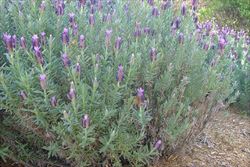
habit in flower (Photo: Sheldon Navie)

habit in fruit (Photo: Sheldon Navie)

leaves (Photo: Sheldon Navie)
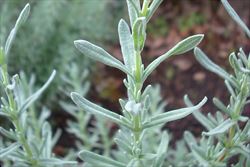
close-up of young stem and paired leaves (Photo: Sheldon Navie)
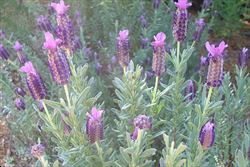
flower clusters (Photo: Sheldon Navie)
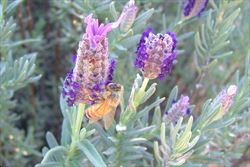
close-up of flower clusters showing the numerous dark purple tubular flowers (Photo: Sheldon Navie)

older flower cluster showing the large petal-like bracts (Photo: Sheldon Navie)
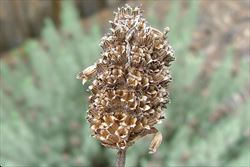
mature fruit (Photo: Sheldon Navie)
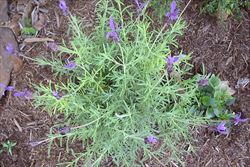
modern ornamental cultivar (Photo: Sheldon Navie)
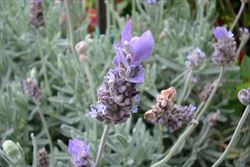
French lavender (Lavandula dentata), with bluish coloured flowers and smaller petal-like bracts (Photo: Sheldon Navie)
Scientific Name
Lavandula stoechas L.
Synonyms
Lavandula stoechas L. subsp. stoechas
Family
Labiatae (South Australia)Lamiaceae (Queensland, New South Wales, the ACT, Victoria, Tasmania, Western Australia and the Northern Territory)
Common Names
bush lavender, French lavender, Italian lavender, Spanish lavender, top lavender, topped lavender, wild lavender
Origin
Native to north-western Africa (i.e. Algeria, Morocco and Tunisia), the Madeira Islands, the Canary Islands, southern Europe (i.e. Greece, Italy, France, Portugal and Spain) and western Asia.
Cultivation
Widely cultivated in the temperate regions of Australia. Numerous cultivars are currently available, including several modern ones that do not set seeds (e.g. 'Avonview', 'Fairy Wings', 'Pukehou', 'Merle', 'Kew Red', 'Marshwood' and 'Ploughman's Purple'). Many of these cultivars are actually hybrids involving this and other Lavandula species.
Naturalised Distribution
Widely naturalised in southern Australia (i.e. in some parts of central and southern New South Wales, in the ACT and Victoria, in eastern South Australia and in south-western Western Australia).
Also naturalised in New Zealand and south-western USA (i.e. California).
Habitat
A weed of pastures, open woodlands, roadsides, disturbed sites, gardens, waste areas and waterways mainly in the temperate regions of Australia.
Habit
A low-growing but mostly upright (i.e. erect) shrub usually less than 60 cm tall, but occasionally reaching up to 1 m in height.
Distinguishing Features
- a low-growing shrub less than 1 m tall.
- its stems are square in cross-section and densely covered in greyish hairs.
- its long and narrow leaves are oppositely arranged, stalkless, and have their margins curved downwards.
- its small purplish tubular flowers are arranged in dense cylindrical clusters (2-5 cm long) at the top of the stems.
- these flower clusters are topped with up to five purple or violet bracts (10-50 mm long).
- the leaves are strongly aromatic when crushed and the flowers give off a lavender perfume.
Stems and Leaves
The stems are upright (i.e. erect or ascending) or occasionally creep along the ground for a short distance and then grow upwards (i.e. decumbent). They are square in cross-section (i.e. quadrangular) and densely covered in greyish-coloured hairs. Older stems are somewhat woody, rougher in texture, and rounded in cross-section.
Like the stems, the leaves are greyish-green in colour and softly hairy (i.e. pubescent). These small leaves (1-3 cm long and 2-5 mm wide) are oppositely arranged along the stems and stalkless (i.e. sessile). They are long and narrow (i.e. linear or lanceolate) with rounded or somewhat pointed tips (i.e. obtuse or sub-acute apices). Their margins are entire, but are usually curved downwards (i.e. recurved).
Flowers and Fruit
Large numbers of inconspicuous tubular flowers are arranged in dense cylindrical clusters (2-5 cm long) at the tips of the stems (i.e. in terminal spikes). These flower clusters are borne on stalks (i.e. peduncles) 1-2.5 cm long and are topped with up to five distinctive, purple or violet coloured, petal-like bracts (10-50 mm long). The small tubular flowers (5-8 mm long) are deep purple in colour and are subtended by deep bluish-purple bracts 12-25 mm long. Their sepals are fused into a short tube (i.e. calyx tube) 4-6 mm long with many veins. The five petals are also fused into a tube (i.e. corolla tube) with five spreading lobes (i.e. corolla lobes). Flowers also have four yellow stamens and an ovary topped with a very short style. They give off a strong lavender perfume and flowering occurs from late winter through to summer (i.e. from August to January), but is most apparent during spring.
The fruit (i.e. a schizocarp) is brown, woody and splits apart when mature into four 'seeds' (i.e. mericarps or nutlets). These 'seeds' (about 2 mm across) are almost round (i.e. sub-globular) and brown mottled with numerous darker spots. They are produced during late spring and early summer.
Reproduction and Dispersal
This species reproduces mainly by seed, which are spread by water, wind, animals an dumped garden waste. The crowns of the plant may also be spread to new areas by machinery, cultivation practices and in dumped garden waste.
Environmental Impact
Topped lavender (Lavandula stoechas) is regarded as a significant environmental weed in South Australia, and as an environmental weed in Victoria and Western Australia. It is also listed as a priority environmental weed in at least one Natural Resource Management region.
This species invades mallee scrublands, lowland grasslands and disturbed grassy woodlands in the temperate regions of Australia. It can form dense stands in these habitats that eliminate all other ground flora, while also severely impeding the regeneration of the over-storey vegetation.
Topped lavender (Lavandula stoechas) is a common environmental weed of the Greater Adelaide and Mount Lofty Ranges region, and is a serious problem in the Clare Valley, in south-eastern South Australia. It has been recorded is several conservation areas in this state (e.g. Ferguson Conservation Park, Greenhill Recreation Park, Belair Reserve and Cleland Conservation Park) and has also invaded remnant habitats where the few remaining colonies of the endangered white beauty spider orchid (Caladenia argocalla) are known to occur.
In Victoria, topped lavender (Lavandula stoechas) is listed as an environmental weed in several local authority areas (e.g. in Knox City, Kingston City and Hume City). In Western Australia it is often found on roadsides, in wasteland, and along creeks and drainage lines between Perth and Manjimup, but also invades grassland, open woodlands and disturbed natural vegetation.
Other Impacts
Topped lavender (Lavandula stoechas ) is not eaten by livestock, and because dense patches of this species eliminate most other vegetation, the loss of production in infested areas can be considerable. It also provides harbour for rabbits and other feral animals.
Legislation
This species is declared under legislation in the following states and territories:
- Victoria: P3 - prohibited and must be eradicated or controlled (in the North Central Goulburn, and West Gippsland regions), and C2 - all reasonable steps must be taken to control the weed and prevent its spread (in the Port Phillip East and North East regions).
- Western Australia: Unassessed - this species is declared in other states or territories and is prohibited until assessed via a weed risk assessment (throughout the entire state).
Management
For information on the management of this species see the following resources:
- Muyt (2001), Bush Invaders of South-east Australia, pp. 190-191.
Similar Species
Topped lavender (Lavandula stoechas) is quite similar to French lavender (Lavandula dentata), and while both species are commonly grown in gardens the latter rarely becomes weedy. These two species can be distinguished by the following differences:
- topped lavender (Lavandula stoechas) leaves have entire margins and its flower clusters have several large purple or violet bracts at their tips (10-50 mm long).
- French lavender (Lavandula dentata) leaves have finely toothed (i.e. dentate) margins and its flower clusters have several smaller pink or purplish bracts at their tips (about 10 mm long).

